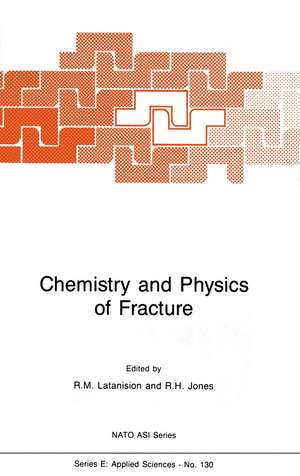Chemistry and Physics of Fracture: NATO Science Series E:, cartea 130
Editat de R.M. Latanision, R.H. Jonesen Limba Engleză Paperback – 30 sep 2011
Din seria NATO Science Series E:
- 24%
 Preț: 1570.70 lei
Preț: 1570.70 lei -
 Preț: 397.76 lei
Preț: 397.76 lei -
 Preț: 386.81 lei
Preț: 386.81 lei - 20%
 Preț: 346.24 lei
Preț: 346.24 lei -
 Preț: 424.33 lei
Preț: 424.33 lei - 18%
 Preț: 1224.18 lei
Preț: 1224.18 lei - 18%
 Preț: 1836.63 lei
Preț: 1836.63 lei - 18%
 Preț: 1229.28 lei
Preț: 1229.28 lei -
 Preț: 381.00 lei
Preț: 381.00 lei -
 Preț: 409.30 lei
Preț: 409.30 lei - 18%
 Preț: 1841.36 lei
Preț: 1841.36 lei - 5%
 Preț: 367.28 lei
Preț: 367.28 lei -
 Preț: 407.19 lei
Preț: 407.19 lei - 18%
 Preț: 1838.38 lei
Preț: 1838.38 lei -
 Preț: 420.28 lei
Preț: 420.28 lei -
 Preț: 399.29 lei
Preț: 399.29 lei -
 Preț: 398.74 lei
Preț: 398.74 lei - 18%
 Preț: 3026.13 lei
Preț: 3026.13 lei -
 Preț: 388.90 lei
Preț: 388.90 lei - 5%
 Preț: 391.06 lei
Preț: 391.06 lei - 18%
 Preț: 1228.62 lei
Preț: 1228.62 lei - 18%
 Preț: 1229.73 lei
Preț: 1229.73 lei - 18%
 Preț: 1234.46 lei
Preț: 1234.46 lei - 5%
 Preț: 3532.05 lei
Preț: 3532.05 lei - 18%
 Preț: 1840.11 lei
Preț: 1840.11 lei - 5%
 Preț: 378.80 lei
Preț: 378.80 lei - 18%
 Preț: 1227.84 lei
Preț: 1227.84 lei -
 Preț: 392.75 lei
Preț: 392.75 lei -
 Preț: 395.63 lei
Preț: 395.63 lei - 18%
 Preț: 2489.30 lei
Preț: 2489.30 lei - 5%
 Preț: 1429.27 lei
Preț: 1429.27 lei -
 Preț: 396.02 lei
Preț: 396.02 lei - 5%
 Preț: 2142.61 lei
Preț: 2142.61 lei - 18%
 Preț: 3049.16 lei
Preț: 3049.16 lei - 18%
 Preț: 1844.54 lei
Preț: 1844.54 lei -
 Preț: 403.53 lei
Preț: 403.53 lei
Preț: 414.14 lei
Nou
Puncte Express: 621
Preț estimativ în valută:
79.25€ • 84.74$ • 66.07£
79.25€ • 84.74$ • 66.07£
Carte tipărită la comandă
Livrare economică 17 aprilie-01 mai
Preluare comenzi: 021 569.72.76
Specificații
ISBN-13: 9789401081405
ISBN-10: 9401081409
Pagini: 748
Ilustrații: 746 p.
Dimensiuni: 155 x 235 x 39 mm
Greutate: 1.03 kg
Ediția:Softcover reprint of the original 1st ed. 1987
Editura: SPRINGER NETHERLANDS
Colecția Springer
Seria NATO Science Series E:
Locul publicării:Dordrecht, Netherlands
ISBN-10: 9401081409
Pagini: 748
Ilustrații: 746 p.
Dimensiuni: 155 x 235 x 39 mm
Greutate: 1.03 kg
Ediția:Softcover reprint of the original 1st ed. 1987
Editura: SPRINGER NETHERLANDS
Colecția Springer
Seria NATO Science Series E:
Locul publicării:Dordrecht, Netherlands
Public țintă
ResearchCuprins
Introductory Lectures.- Chemistry and Physics of Fracture: An Overview.- What, If Anything, Can Chemistry Offer to Fracture Mechanics?.- Mechanics of Brittle Cracking of Crystal Lattices and Interfaces.- Materials Science of Fracture Processes.- Theory of Fracture.- Plastic Processes at Crack Tips.- Discussion: Remark Concerning the Evidence of Cleavage in Our Experiments in Single Crystals of Fe2.6%Si.- Plastic Flow Instabilities at Crack Tips.- Distributed Damage Processes in Fracture.- A Comparison of Void Growth and Ductile Failure in Plane and Axisymmetric States of Strain.- Solid State Chemistry and Physics of Fracture.- Theoretical Approaches to Materials Design: Intergranular Embrittlement.- Interatomic Forces and the Simulation of Cracks.- Application of the Embedded Atom Method to Hydrogen Embrittlement.- Theory of Environmental Effects on Transgranular Fracture.- Solution Chemistry.- Surface Chemistry in Aqueous Solutions.- Crack-Tip Electrochemistry: Recent Developments.- Electrochemical Thermodynamics and Kinetics and Their Application to the Study of Stress-Corrosion Cracking.- Structure and Properties of Interfaces.- Universal Properties of Bonding at Metal Interfaces.- Structure of Grain Boundaries and Interfaces.- Segregation at Interfaces.- Workshop Sessions.- Workshop Session 1: Novel Aspects of Fracture.- Novel Techniques as Applied to Fracture Process Zone Theory.- Short Presentations.- In Situ TEM Studies of Crack Tip Deformation in Molybdenum.- Quantitative Study of Striations in Stage II Fatigue Crack Growth.- The Brittle-Ductile Transition of Silicon.- Workshop Summary.- Workshop Session 2: Intergranular Embrittlement.- Intergranular Fracture.- Short Presentations.- Structure-Dependent Intergranular Fracture and the Control of Embrittlement of Polycrystals.- Brittle-Ductile Behavior of Materials. [Presentation only].- Workshop Summary.- Workshop Session 3: Hydrogen Embrittlement.- The Role of Hydrogen Transport in Hydrogen Embrittlement.- Hydrogen Induced Fracture.- Short Presentations.- Simple Practical and Theoretical Prediction of Hydrogen Sensitivity of Material. [Presentation only].- Surface Hydrogen and Fracture Stress of 4340 Steel.- Hydrogen Effects in Nickel Based Superalloy Single Crystals.- Hydrogen-Induced Phase Transformations in Thin Specimens of an Austenitic Stainless Steel.- A System of Cracks in Bonded Half Planes.- Stress-Corrosion Cracking of Mild Steel in Anhydrous Ammonia Environments: Nitrogen Embrittlement?. [Presentation only].- Inelastic Neutron Scattering and Resistivity of Hydrogen in Cold-Worked Palladium.- Fracture Initiation Due to Hydrides in Zircaloy-2.- Workshop Summary.- Workshop Session 4: Stress Corrosion and Corrosion Fatigue.- Film-Induced Cleavage During Stress-Corrosion Cracking of Ductile Metals and Alloys.- Corrosion Fatigue of Metals: A Survey of Recent Advances and Issues.- Short Presentations.- Stress Corrosion Cracking of A 508 Steel in Saturated MnS-Solution.- Experiments on Bicrystals Concerning the Influence of Segregation and Slip on Stress Corrosion Cracking.- Stress-Corrosion Cracking of Cu-25Au Single Crystals in Aqueous Chloride Media.- Role of Sulfur in the Formation and the Breakdown of Passive Films.- Breakdown and Formation Process of Titanium Oxide Film During Straining in Aqueous Electrolyte.- Nucleation of Kinks on Cracks. [Presentation only].- Initiation and Evolution of Microcracks During Corrosion Fatigue of BCC Stainless Steels.- Workshop Summary.- Summary Session.- Chemistry and Physics of Fracture: A Conference Summary.- List of Participants.











